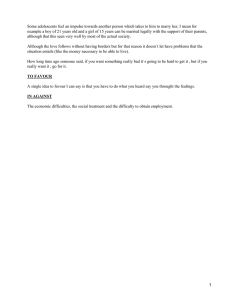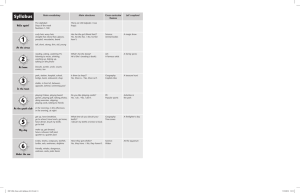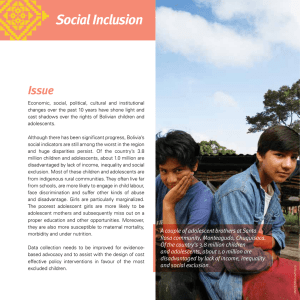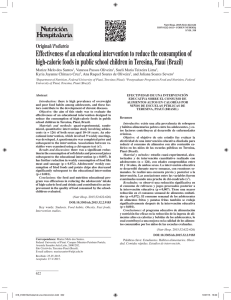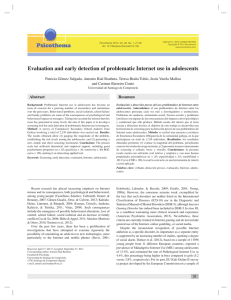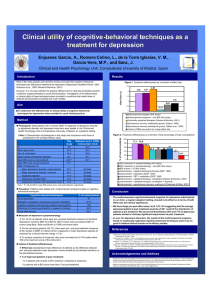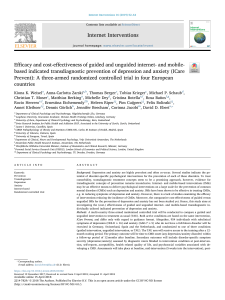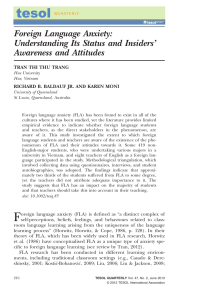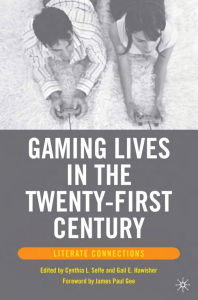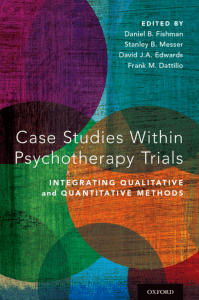Problem video game playing is related to emotional
Anuncio
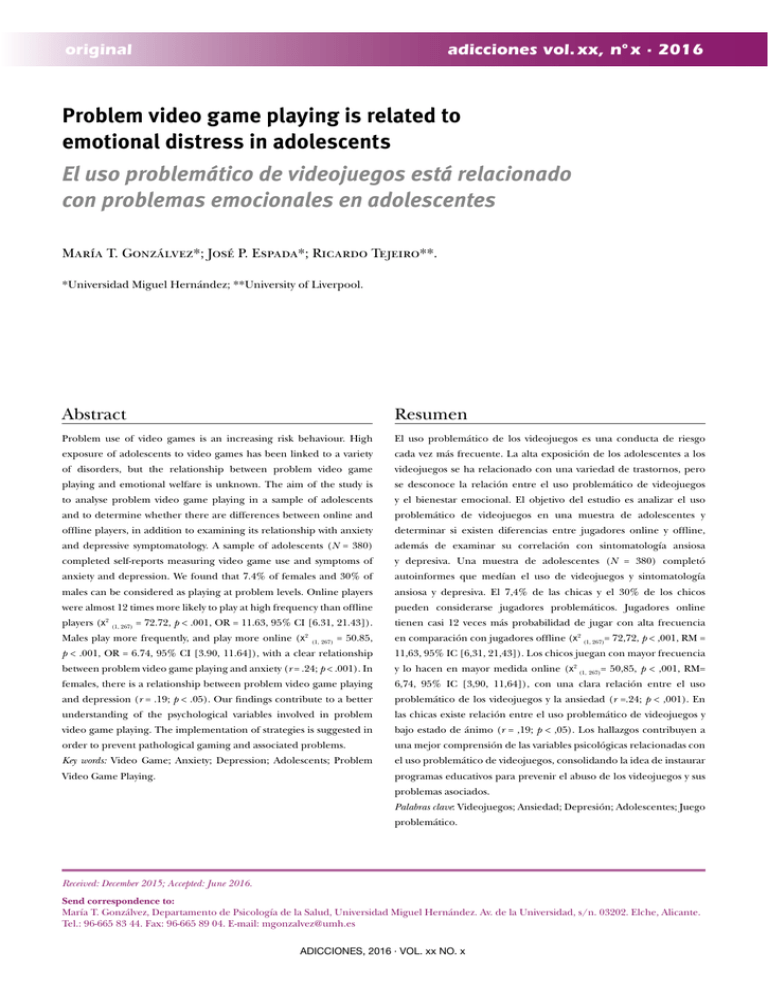
original adicciones vol. xx, nº x · 2016 Problem video game playing is related to emotional distress in adolescents El uso problemático de videojuegos está relacionado con problemas emocionales en adolescentes María T. Gonzálvez*; José P. Espada*; Ricardo Tejeiro**. *Universidad Miguel Hernández; **University of Liverpool. Abstract Resumen Problem use of video games is an increasing risk behaviour. High El uso problemático de los videojuegos es una conducta de riesgo exposure of adolescents to video games has been linked to a variety cada vez más frecuente. La alta exposición de los adolescentes a los of disorders, but the relationship between problem video game videojuegos se ha relacionado con una variedad de trastornos, pero playing and emotional welfare is unknown. The aim of the study is se desconoce la relación entre el uso problemático de videojuegos to analyse problem video game playing in a sample of adolescents y el bienestar emocional. El objetivo del estudio es analizar el uso and to determine whether there are differences between online and problemático de videojuegos en una muestra de adolescentes y offline players, in addition to examining its relationship with anxiety determinar si existen diferencias entre jugadores online y offline, and depressive symptomatology. A sample of adolescents (N = 380) además de examinar su correlación con sintomatología ansiosa completed self-reports measuring video game use and symptoms of y depresiva. Una muestra de adolescentes (N = 380) completó anxiety and depression. We found that 7.4% of females and 30% of autoinformes que medían el uso de videojuegos y sintomatología males can be considered as playing at problem levels. Online players ansiosa y depresiva. El 7,4% de las chicas y el 30% de los chicos were almost 12 times more likely to play at high frequency than offline pueden considerarse jugadores problemáticos. Jugadores online players (χ2 (1, 267) = 72.72, p < .001, OR = 11.63, 95% CI [6.31, 21.43]). tienen casi 12 veces más probabilidad de jugar con alta frecuencia Males play more frequently, and play more online (χ2 = 50.85, en comparación con jugadores offline (χ2 (1, 267)= 72,72, p < ,001, RM = p < .001, OR = 6.74, 95% CI [3.90, 11.64]), with a clear relationship 11,63, 95% IC [6,31, 21,43]). Los chicos juegan con mayor frecuencia between problem video game playing and anxiety (r = .24; p < .001). In y lo hacen en mayor medida online (χ2 (1, 267)= 50,85, p < ,001, RM= females, there is a relationship between problem video game playing 6,74, 95% IC [3,90, 11,64]), con una clara relación entre el uso and depression (r = .19; p < .05). Our findings contribute to a better problemático de los videojuegos y la ansiedad (r =.24; p < ,001). En understanding of the psychological variables involved in problem las chicas existe relación entre el uso problemático de videojuegos y video game playing. The implementation of strategies is suggested in bajo estado de ánimo (r = ,19; p < ,05). Los hallazgos contribuyen a order to prevent pathological gaming and associated problems. una mejor comprensión de las variables psicológicas relacionadas con Key words: Video Game; Anxiety; Depression; Adolescents; Problem el uso problemático de videojuegos, consolidando la idea de instaurar Video Game Playing. programas educativos para prevenir el abuso de los videojuegos y sus (1, 267) problemas asociados. Palabras clave: Videojuegos; Ansiedad; Depresión; Adolescentes; Juego problemático. Received: December 2015; Accepted: June 2016. Send correspondence to: María T. Gonzálvez, Departamento de Psicología de la Salud, Universidad Miguel Hernández. Av. de la Universidad, s/n. 03202. Elche, Alicante. Tel.: 96-665 83 44. Fax: 96-665 89 04. E-mail: [email protected] ADICCIONES, 2016 · VOL. xx NO. x Problem video game playing is related to emotional distress in adolescents T he increased presence and use of information and communication technologies in today’s society occurs primarily amongst children and adolescents (Lorenci, 2012). Internet Gaming Disorder (IGD) is one of the new conditions for further study included in the fifth edition of the Diagnostic and Statistical Manual of the American Psychiatric Association (DSM-5; APA, 2013), defined as a “persistent and recurrent use of the Internet to engage in games, often with other players, leading to clinically impairment or distress as indicated by five (or more) of the following in a twelve- month period: preoccupation, withdrawal, tolerance, loss of control, loss of interest in previous hobbies, continued use despite knowledge of psychosocial problems, deception, escape and conflict with relationships, and job or school (p. 795)”. The individuals presenting this problem typically face serious impairment in significant areas such as school, work or relationships (APA, 2013). Chamarro et al. (2014) claim that the use of video games becomes problematic when their healthy use generates psychological dependence: avoidance of problems, mood modification, loss of control, and targeting. A growing number of studies highlight the differences between online and offline gaming. Unlike traditional video games, online video games integrate play within an Internet-based social context, creating a distinctive environment for social play (Kowert & Oldmeadow, 2013). The social elements contained within this environment constitute a primary reason for continued play frequency and extended duration (Caplan, Williams, & Yee, 2010). Online video games are more likely than offline games to be associated with problem use (Porter, Starcevic, Berle, & Fenech, 2010), and it has been suggested that online gaming way have a greater addictive potential (Ng & Wiemer-Hastings, 2005). Prevalence rates of problematic Internet use in Spanish studies vary between 3.7% and 9.9% (Muñoz-Rivas, Fernández, & Gámez-Guadix, 2010). In 2014, online gambling platforms registered an average of 130,000 new players per month (Buil, Moratilla, & Ruiz, 2015). Similarly, it has been reported that 6.1% (Chamarro et al., 2014) to 8.2% (Oliva, 2012) of Spanish adolescents may be addicted to video games, with higher pathological gaming in boys as compared to girls (Labrador & Villadangos, 2010; Oliva, 2012). Some social factors might explain the acquisition of gaming behaviours: high availability, easy accessibility, great social acceptance, high diffusion and lax legal restrictions (Blanco, González, & Martos, 2015). Pathological gaming has been linked to the expectation of positive moods or relieving negative moods (Shead, Callan, & Hodgins, 2008) and some evidence has been found on the mediation of emotional regulation in the emergence of a compulsive use of video games (Haagsma, Caplan, Peters, & Pieter- se, 2013). Some studies have revealed the mediation of emotional regulation in the development of pathological gaming problems (Estévez, Herrero, Sarabia, & Jáuregui, 2014; Schreiber, Grant, & Odlaug, 2012), and it has been suggested that the abuse of video games could influence negatively on anxiety and depressive symptoms (Martínez, Betancourt, & González, 2013; Tortolero et al., 2014) – although most studies focus on aggressive games. Lafrenière, Vallerand, Donahue, and Lavigne (2009) found that gamers who were obsessively involved showed negative affective experiences; consistently, other have reported that problematic use of video games is associated with elevated levels of anxiety and depression (Mentzoni et al., 2011). In this regard, a study by Vazquez et al. (2013) with Spanish adolescents found a prevalence of negative mood in 14.9% of boys and 16.9% of girls, reaching 20.7% in high school ages. Further, problem use of videogames seems to be associated with interference and misalignment in lifestyle – with important consequences for adolescents (Beranuy, Chamarro, Graner, & Carbonell, 2009). Some of the negative social effects of abusing video games include weak affective relationships with parents and people their own age, and the strengthening of social racial or sexual stereotypes (Dickerman, Christensen, & Kerl-McClain, 2008). The relationship between video game abuse and anxiety and depression in Spanish adolescents is still to be established. The first aim of this paper is to analyze problem video game playing in a sample of adolescents and to determine whether differences exist between online and offline players. Second, it is intended to give evidence about the association between video game use and anxiety and depression symptomatology in Spanish adolescents. Our hypotheses, based on previous studies, are that there is a high problem video game playing prevalence, with differences between online and offline players; and that the use of video games at problem level is associated with higher anxiety and higher depression. Method Participants The research team contacted a convenience sample of 35 schools in five Spanish cities in the province of Alicante, and all the schools that agreed to participate were included in the study. The sample was formed by 380 students from three public schools (all participants invited to participate in the study agreed to do so). Participants were aged 12 to 17 (M = 14.9, SD = 1.46); 14.7% were aged 12-13, 48.2% were aged 14.15 and 37.1% were aged 16-17, and were equally distributed between males and females, with no gender differences across age groups. The majority (92.6%) had Spanish nationality; 7.4% were distribu- ADICCIONES, 2016 · VOL. xx NO. x María T. Gonzálvez, José P. Espada, Ricardo Tejeiro ted across 18 additional nationalities, and the nationality of one participant was unreported. In compliance with school requirements, no data were collected regarding ethnic group or socio-economic levels, but the vast majority of participants were White (Caucasian) middleclass students. Instruments Socio-demographics were assessed with items including age, gender, and nationality. Use of video games was measured with the Spanish version of the Problem Video Game Playing scale (PVP; Tejeiro & Moran, 2002). The PVP scale is a nine-item dichotomous questionnaire based on the DSM-IV (APA, 1994) criteria for substance dependence and for pathological gaming, as well as the literature on addictions. The original items in Spanish were utilized, but the reference to ‘stealing’ was deleted from item 8 in order to increase the similarity between this item and the DSM-5 criteria for IGD and substance use disorder. Different studies in a variety of countries and settings have confirmed that the PVP is one-dimensional, has a good internal consistency (Cronbach’s alpha .69 to .91), and strong convergent and criterion validity (e.g., López-Fernández, Honrubia-Serrano, Baguley, & Griffiths, 2014). In this study, the PVP’s internal consistency coefficient was low (Cronbach’s α = .58); no item could be excluded in either subsample because that would have a negative effect on alpha. Several cutoff points have been suggested for the PVP: three (Arab et al., 2007), four (Tejeiro, Gómez-Vallecillo, Pelegrina, Wallace, & Emberley, 2012), five (Adiele & Olatokun, 2014) and six (López-Fernández et al., 2014). The cutoff point in this study was four, which is the lower bound of the range suggested by the DSM-5 to consider a substance use disorder as of moderate severity. Anxiety and depression were measured with the Goldberg, Bridges, Duncan-Jones, and Grayson (1988) scales. Derived by latent trait analysis from a standardized psychiatric research interview, these scales provide dimensional measures of the severity of each disorder. Each scale is formed by nine items (dichotomous response; one point for each affirmative answer), but the full set of questions needs to be administered only if the first four items have registered at least two positive answers (in the scale of anxiety) or at least one positive answer (in the scale of depression). The cutoffs are located in four or more for anxiety and in two or more for depression, with higher scores indicating higher severity. The authors indicate that an individual with a score at the cutoff for either scale has a 50% chance of having a clinically important disturbance, and above these scores the probability rises sharply. The total score has a specificity of .84 and a sensitivity of .75. In our study, Cronbach´s alpha values were moderate at α = .71 for the anxiety scale and α = .66 for the depression scale. Procedure After approval of the study by an ethics committee at Universidad Miguel Hernández as well as by the school boards – ensuring that the study does not involve risk to participants and respects human rights –, adolescents and their parents were informed about its objectives and provided written informed assent and consent, respectively. All measures to ensure confidentiality and anonymity were implemented and explained to the participants. After some short oral instructions, the surveys were administered by two members of the research team to groups of around 30 participants in their regular classrooms during school hours. Completion of the questionnaires required 10 to 20 minutes. Data analysis The SPSS version 21.0 statistical package and Amos version 21.0 were utilized for data analyses. Chi-square tests were used for nominal variables and the effect size was measured with odds ratio and φ for binary variables, and with Cramer’s V or φc for categorical non-dichotomous variables. Normality (Shapiro-Wilk) and homoscedasticity (Levene’s) tests were conducted for each variable and, according to the results, either parametric (Student’s t) or nonparametric (Mann-Whitney’s U) tests were conducted; the effect size was measured with Cohen’s d for Gaussian variables and with r for non-Gaussian variables (Fritz, Morris, & Richler, 2012). Results Use of Video Games The vast majority of participants had played video games in the past year (86.1%), with 36.1% being frequent players (daily or almost daily). Males were 4.6 times more likely than females to play frequently; 52.6% males, 19.5% females, χ2 (1, 380) = 45.30, p < .001, OR = 4.60, 95% CI [2.91, 7.27]; no differences in high frequency were found across age groups. Most participants played only or mostly offline (42.4%), with the remaining fairly distributed between online gaming (27.9%) and both types (29.5%); males played online (63.3%) significantly more than females (20.4%); χ2 = 50.85, p < .001, OR = 6.74, 95% CI [3.90, 11.64]; age (1, 267) groups did not differ in online vs. offline playing (39.1% of online gamers in 11-13 years-old, 36.3% in 14-15, and 44.3% in 16-17). Online players were almost 12 times more likely to play at high frequency (62.3%) than offline players (12.4%); χ2 (1, 267) = 72.72, p < .001, OR = 11.63, 95% CI [6.31, 21.43]. A logistic regression with high frequency as dependent variable found that greater likelihood persisted even when gender and age were controlled for, OR = 9.27, 95% CI [4.83, 17.80]. Table 1 shows participant’s scores. Males scored significantly higher than females in the PVP (U = 10957, p < .001, r = .35). No difference was found across the age groups. With a cutoff point of four, 7.4% of ADICCIONES, 2016 · VOL. xx NO. x Problem video game playing is related to emotional distress in adolescents Table 1. Scores in the Problem Video game Playing questionnaire (PVP) and Goldberg et al.’s (1988) scales. Males (n = 189) Females (n = 191) Total (N = 380) 2.48 (1.81)** 1.27 (1.81) 1.88 (1.67) Online players 3.56 (1.56)** 1.78 (1.25) 2.67 (1.81)** Offline players 1.32 (1.02) 1.14 (0.83) 1.23 (1.29) Anxiety 2.56 (1.88) 4.01 (2.42)** 3.29 (2.29) Depression 1.61 (1.61) 2.23 (2.00)* 1.92 (1.84) PVP Table 2. Significance of differences between problem and nonproblem gamers in scores above the cutoff points for anxiety and depression. χ2 d.f. p OR (CI 95%) Anxiety 1.57 1 < .001 3.15 (1.64-6.04) Depression 0.92 1 .09 1.83 (0.97-3.45) Note. * p < ,05; ** p < ,001 females and 30% of males can be considered as playing at problem levels; OR = 5.39, 95% CI [2.88, 10.08]. The score for online gamers was significantly higher than the score for offline gamers (U = 4441.5, p < .001, r = .42); 33% of online gamers and 6.8% of offline gamers (16.5% of total gamers) scored above the cutoff point of four, with 75% of all problem gamers playing online. Anxiety and Depression Of all participants, 53.4% scored above the cutoff point for anxiety; females scored higher than males (U = 11592, p < .001, r = .31). For depression, 47.6% of participants scored above the cutoff point; females also scored higher than males (U = 14804.5, p = .003, r = .15). Table 1 shows the scores for each of the scales. Spearman’s correlations revealed that, for females, only the correlation between the PVP total score and score in depression was significant (r = .19; p < .05), but this relationship lost significance when partial correlation controlling for online vs. offline gaming was calculated. For males, PVP total score correlated significantly with depression (r = .21; p < .05) and anxiety (r = .24; p < .001) scores, even when partial correlation controlling for online vs. offline gaming was calculated (r = .30, p = .001 for both anxiety and depression). Amongst males, problem gamers were three times more likely than non-problem gamers to score above the cutoff point in the anxiety scale (OR = 3.15, 95% CI [1.64, 6.04]) and almost twice as likely to score above the cutoff point in the depression scale (OR = 1.83, 95% CI [0.97, 3.45]), although the later was not statistically significant; see Table 2. Also, male problem gamers scored significantly higher in anxiety (U = 2769, p = .006, r = .20) and in depression (U = 2996.5, p = .029, r = .16) as compared to male non-problem gamers. No significant difference of any sort was found for females. Discussion Our aim was to measure problem video game playing, anxiety and depression in a sample of Spanish adolescents and to analyze their relationships. We found that 86.1% of adolescents had played video games in the past year; this result is consistent with those of Beltrán, Beltrán, Moreno, Cervelló, & Montero (2012), although our study draws attention to the higher percentage of frequent players (36.1%, daily or almost daily). As in previous studies (Chamarro et al., 2014; Chóliz & Marco, 2011; Labrador & Villadangos, 2010), males were more likely than females to play frequently and also to be online players, thus posing a greater addictive potential (Ng & Wiemer-Hastings, 2005). The individuals presenting Internet Gaming Disorder typically face serious impairment in significant areas (APA, 2013). Anxiety and depression symptoms and disorders are the most prevalent psychological problems in adolescents (Skrove, Romundstad, & Indredavik, 2013), especially in females (Rosa-Alcázar, Parada-Navas, & Rosa-Alcázar, 2014). As hypothesized, we found a clear relationship between problem video game playing and anxiety (and to a lesser degree also with depression), but only in males. In females, only a weak relationship was found between problem video game playing and depression, and it lost significance when online vs. offline gaming was controlled for. Mehroof and Griffiths (2010) established that trait and state anxiety display significant associations with gaming addiction, and some traits as neuroticism, sensation seeking, and aggression, might lead individuals to pathological gaming (Gyollai et al., 2014). It seems reasonable to assume that interventions should then begin with the detection of these personality traits, to prevent problem video game playing development. Usually the game is not played to obtain a benefit or a reward, but for the pleasure or intrinsic interest (Chóliz & Marco, 2011), facilitated by the games’ structural and functional features (Lee & LaRose, 2007). Adolescent video gamers get short-term rewards, but in turn present anxiety and depression symptoms, which may lead to the increased use of video games as a strategy to avoid or escape situations, everyday experiences of stress, and exhaustion (Muros, Aragón, & Bustos, 2013), but future studies should clarify the direction of this relationship. ADICCIONES, 2016 · VOL. xx NO. x María T. Gonzálvez, José P. Espada, Ricardo Tejeiro Despite some clear limitations, such as the opportunistic and convenience sample and the self-report method, and relatively poor psychometric properties of some of the scales used, our study provides the first empirical evidence of the association between excessive use of video games and anxiety and depression amongst Spanish adolescent. Furthermore, for adolescents with certain risk profiles, the misuse of video games may cause social, family and school problems. The early detection of the problem use of video games, especially among adolescents at risk of emotional problems, is therefore necessary in order to prevent and minimize other negative outcomes such as emotional disorders related to anxiety and depression. Financing This study was supported by the Vali+D program of the Culture, Education, and Science Department, Valencian Community Government (Ref. ACIF/2014/047). Conflicts of interest There are no conflicts of interest. References Adiele, I. & Olatokun, W. (2014). Prevalence and determinants of Internet addiction among adolescents. Computers in Human Behaviour, 31, 100-110. doi:10.1016/j. chb.2013.10.028. American Psychiatric Association (1994). Diagnostic and statistical manual of mental disorders, Fourth Edition. Arlington, VA: American Psychiatric Association. American Psychiatric Association (2013). Diagnostic and statistical manual of mental disorders, Fifth Edition. Arlington, VA: American Psychiatric Association. Arab, E., Sommer, K., Herskovic, V., Sommer, S., Sandoval, C. & Poblete, C. (2007). Evaluación del uso del video juego en escolares de la Región Metropolitana. Revista Chilena de Psiquiatría y Neurología de la Infancia y la Adolescencia, 18, 7-11. Beltrán, V. J., Beltrán, J. I., Moreno, J. A., Cervelló, E. & Montero, C. (2012). El uso de videojuegos activos entre los adolescentes. CCD. Cultura_Ciencia_Deporte, 7, 19-24. doi:10.12800/ccd.v7i19.20. Beranuy, M., Chamarro, A., Graner, C. & Carbonell, X. (2009). Validación de dos escalas breves para evaluar la adicción a Internet y el abuso de móvil. Psicothema, 21, 480-485. Blanco, P., González, M. & Martos, C. (2015). El juego como adicción social: crónica de una patología anunciada. Alternativas: Cuadernos de Trabajo Social, 22, 9-22. Buil, P., Moratilla, M. J. S. & Ruiz, P. G. (2015). La regulación publicitaria de los juegos de azar online en España. Una reflexión sobre la protección del menor. Adicciones, 27, 198-204. Caplan, S., Williams, D. & Yee, N. (2010). Problematic Internet use and psychosocial well-being among MMO players. Computers in Human Behaviour, 25, 1312–1319. Chamarro, A., Carbonell, X., Manresa, J. M., Muñoz-Miralles, R., Ortega-González, R., López-Morron, M. R., …, Toran-Montserrat, P. (2014). El Cuestionario de Experiencias Relacionadas con los Videojuegos (CERV): Un instrumento para detectar el uso problemático de videojuegos en adolescentes españoles. Adicciones, 26, 303-311. Chóliz, M. & Marco, C. (2011). Patrón de uso y dependencia de videojuegos en infancia y adolescencia. Anales de Psicología, 27, 418-426. Dickerman, C., Christensen, J. & Kerl-McClain, S. B. (2008). Big breasts and bad guys: Depictions of gender and race in video games. Journal of Creativity in Mental Health, 3, 20-29. doi:10.1080/15401380801995076. Estévez, A., Herrero, D., Sarabia, I. & Jáuregui, P. (2014). Mediating role of emotional regulation between impulsive behaviour in gambling, Internet and videogame abuse, and dysfunctional symptomatology in young adults and adolescents. Adicciones, 26, 282-290. Fritz, C. O., Morris, P. E. & Richler, J. J. (2012). Effect size estimates: current use, calculations, and interpretation. Journal of Experimental Psychology: General, 141, 2-18. doi:10.1037/a0024338. Goldberg, D., Bridges, K., Duncan-Jones, P. & Grayson, D. (1988). Detecting anxiety and depression in general medical settings. British Medical Journal, 297, 897-899. doi:10.1136/bmj.297.6653.897. Gyollai, A. D., Griffiths, M., Barta, C., Vereczkei, A., Urban, R., Kun, B., …, Demetrovics, Z. (2014). The genetics of problem and pathological gambling: a systematic review. Current Pharmaceutical Design, 20, 3993-3999. doi: 10.2174/13816128113199990626. Haagsma, M. C., Caplan, S. E., Peters, O. & Pieterse, M. E. (2013). A cognitive-behavioural model of problematic online gaming in adolescents aged 12-22 years. Computers in Human Behaviour, 29, 202-209. doi:10.1016/j. chb.2012.08.006. Kowert, R. & Oldmeadow, J. A. (2013). Social reputation: Exploring the relationship between online video game involvement and social competence. Computers in Human Behaviour, 29, 1872–1878. doi:10.1016/j. chb.2013.03.003. Labrador, F. J. & Villadangos, S. M. (2010). Menores y nuevas tecnologías: conductas indicadoras de posible problema de adicción. Psicothema, 22, 180-188. Lafrenière, M. C., Vallerand, R. J., Donahue, E. G. & Lavigne, G. L. (2009). On the costs and benefits of gaming: the role of passion. CyberPsychology & Behaviour, 12, 285290. doi:10.1089/cpb.2008.0234. ADICCIONES, 2016 · VOL. xx NO. x Problem video game playing is related to emotional distress in adolescents Lee, D. & LaRose, R. (2007). A socio-cognitive model of video game usage. Journal of Broadcasting & Electronic Media, 51, 632-650. doi:10.1080/08838150701626511. López-Fernández, O., Honrubia-Serrano, L. M., Baguley, T. & Griffiths, M. D. (2014). Pathological video game playing in Spanish and British adolescents: Towards the exploration of Internet Gaming Disorder symptomatology. Computers in Human Behaviour, 41, 304-312. doi:10.1016/j.chb.2014.10.011. Lorenci, M. (2012). Anuario SGAE de las Artes Escénicas, musicales y audiovisuales. Fundación Autor: Madrid. Martínez, P., Betancourt, D. & González, A. (2013). Uso de videojuegos, agresión, sintomatología depresiva y violencia intrafamiliar en adolescentes y adultos jóvenes. Revista Colombiana de Ciencias Sociales, 4, 167-180. Mehroof, M. & Griffiths, M. D. (2010). Online gaming addiction: the role of sensation seeking, self-control, neuroticism, aggression, state anxiety, and trait anxiety. Cyberpsychology, Behaviour, and Social Networking, 13, 313316. doi:10.1089/cyber.2009.0229. Mentzoni, R. A., Brunborg, G. S., Molde, H., Myrseth, H., Skouveroe, K. J. M., Hetland, J. & Pallesen, S. (2011). Problematic video game use: estimated prevalence and associations with mental and physical health. Cyberpsychology, Behaviour, and Social Networking, 14, 591-596. doi:10.1089/cyber.2010.0260. Muñoz-Rivas, M. J., Fernández, L. & Gámez-Guadix, M. (2010). Analysis of the indicators of pathological Internet use in Spanish university students. The Spanish Journal of Psychology, 13, 131-137. doi:10.1017/ s1138741600002365. Muros, B., Aragón, Y. & Bustos, A. (2013). La ocupación del tiempo libre de jóvenes en el uso de videojuegos y redes. Comunicar, 20, 31-39. doi:10.3916/c40-2013-02-03. Ng, B. D. & Wiemer-Hastings, P. (2005). Addiction to the internet and online gaming. Cyberpsychology & Behaviour, 8, 110-113. doi:10.1089/cpb.2005.8.110. Oliva, A. (2012). Uso y riesgo de adicciones a las nuevas tecnologías entre adolescentes y jóvenes andaluces. Sevilla: Aguaclara. Porter, G., Starcevic, V., Berle, D. & Fenech, P. (2010). Recognizing problem video game use. Australian and New Zealand Journal of Psychiatry, 44, 120–128. Rosa-Alcázar, A. I., Parada-Navas, J. L. & Rosa-Alcázar, A. (2014). Síntomas psicopatológicos en adolescentes españoles: relación con los estilos parentales percibidos y la autoestima. Anales de Psicología, 30, 133-142. doi:10.6018/analesps.30.1.165371. Schreiber, L. N., Grant, J. E. & Odlaug, B. L. (2012). Emotion regulation and impulsivity in young adults. Journal of Psychiatric Research, 46, 651-658. doi:10.1016/j.jpsychires.2012.02.005. Shead, N., Callan, M. J. & Hodgins, D. C. (2008). Probability discounting among gamblers: Differences across problem gambling severity and affect-regulation expectancies. Personality and Individual Differences, 45, 536-541. doi:10.1016/j.paid.2008.06.008. Skrove, M., Romundstad, P. & Indredavik, M. S. (2013). Resilience, lifestyle and symptoms of anxiety and depression in adolescence: the Young-HUNT study. Social Psychiatry and Psychiatric Epidemiology, 48, 407-416. doi:10.1007/s00127-012-0561-2. Tejeiro, R., Gómez-Vallecillo, J., Pelegrina, M., Wallace, A. & Emberley, E. (2012). Risk factors associated with the abuse of video games in adolescents. Psychology, 3, 310314. doi:10.4236/psych.2012.34044. Tejeiro, R. & Moran, R. B. (2002). Measuring video game pathological playing in adolescents. Addiction, 97, 16011606. doi:10.1046/j.1360-0443.2002.00218.x. Tortolero, S. R., Peskin, M. F., Baumler, E. R., Cuccaro, P. M., Elliott, M. N., Davies, S. L., …, Schuster, M. A. (2014). Daily violent video game playing and depression in preadolescent youth. Cyberpsychology, Behaviour, and Social Networking, 17, 609-615. doi:10.1089/cyber.2014.0091. Vázquez, M. E., Muñoz, M. F., Fierro, A., Alfaro, M., Rodríguez, L. & Bustamante, P. (2013). Estado de ánimo de los adolescentes y su relación con conductas de riesgo y otras variables. Revista Pediatría de Atención Primaria, 15, 219. doi:10.4321/s1139-76322013000400003. ADICCIONES, 2016 · VOL. xx NO. x
